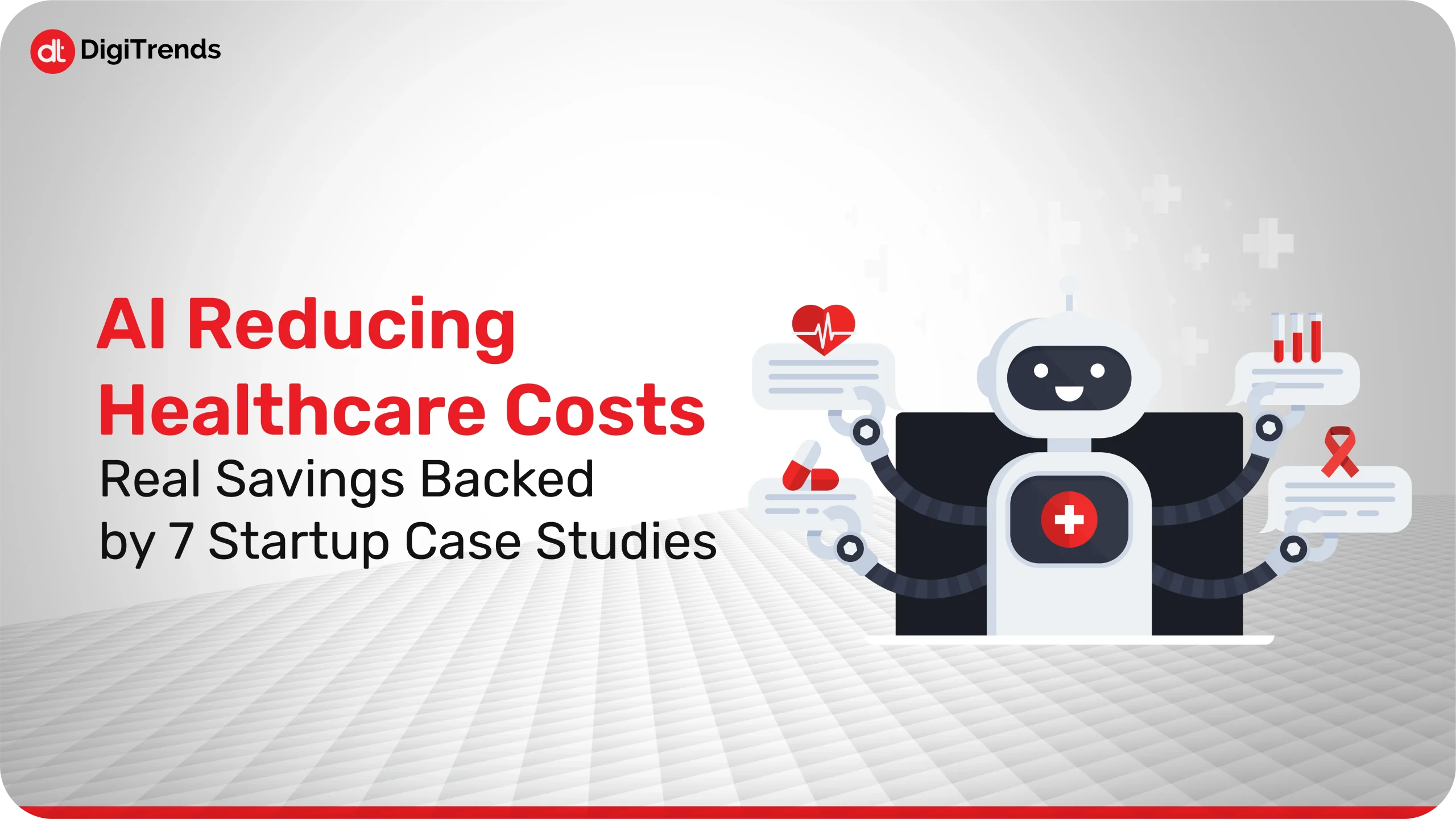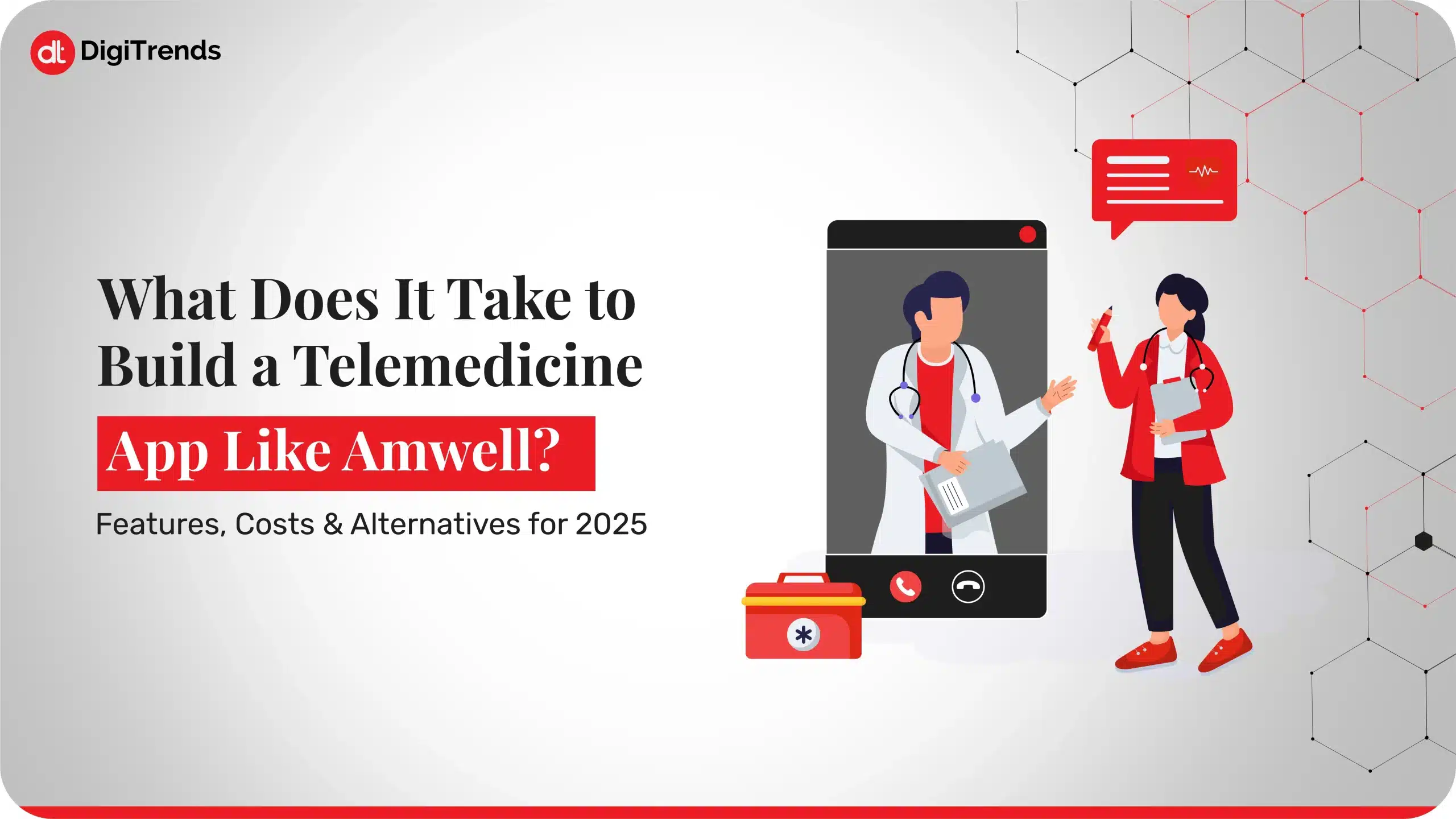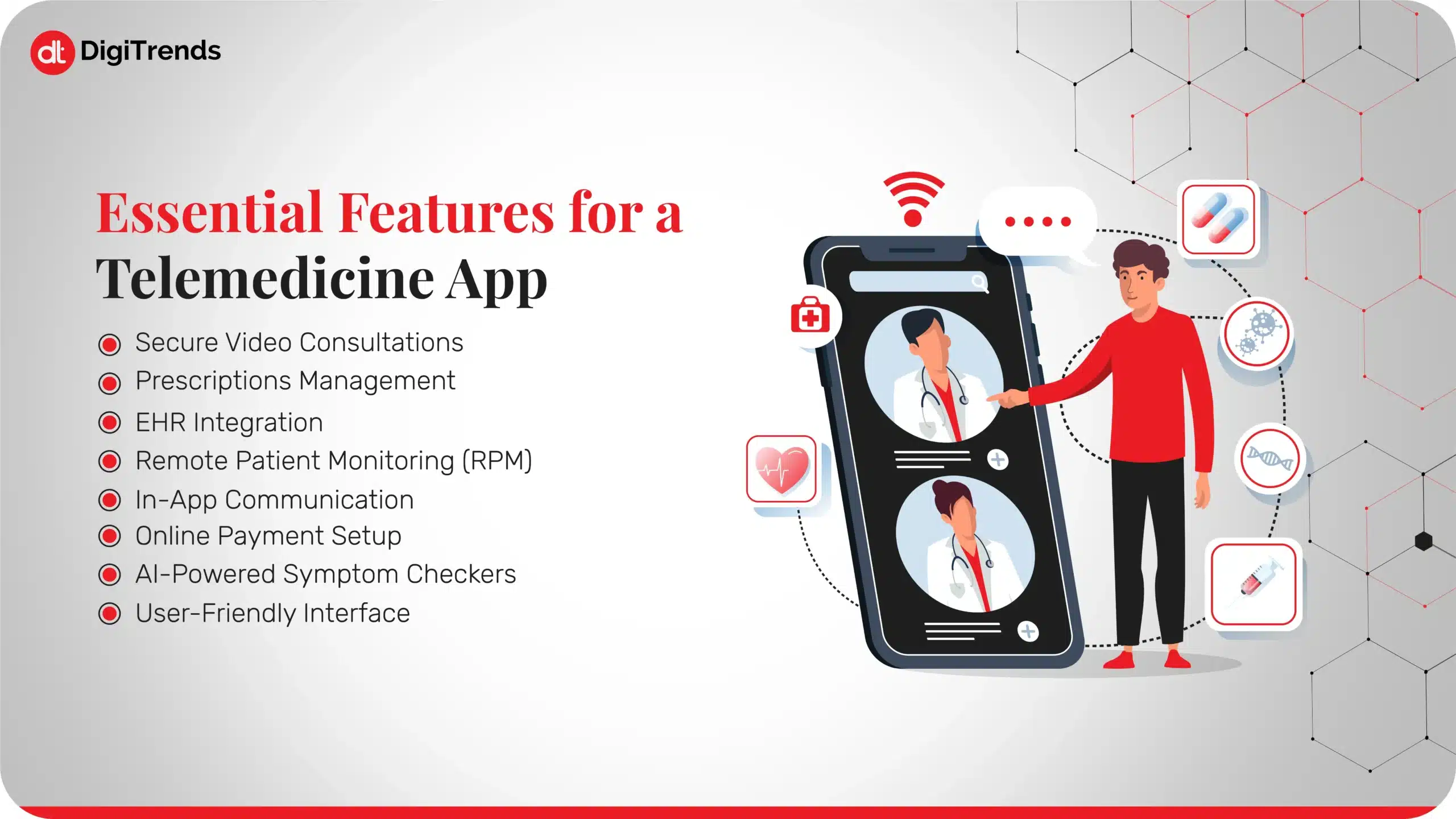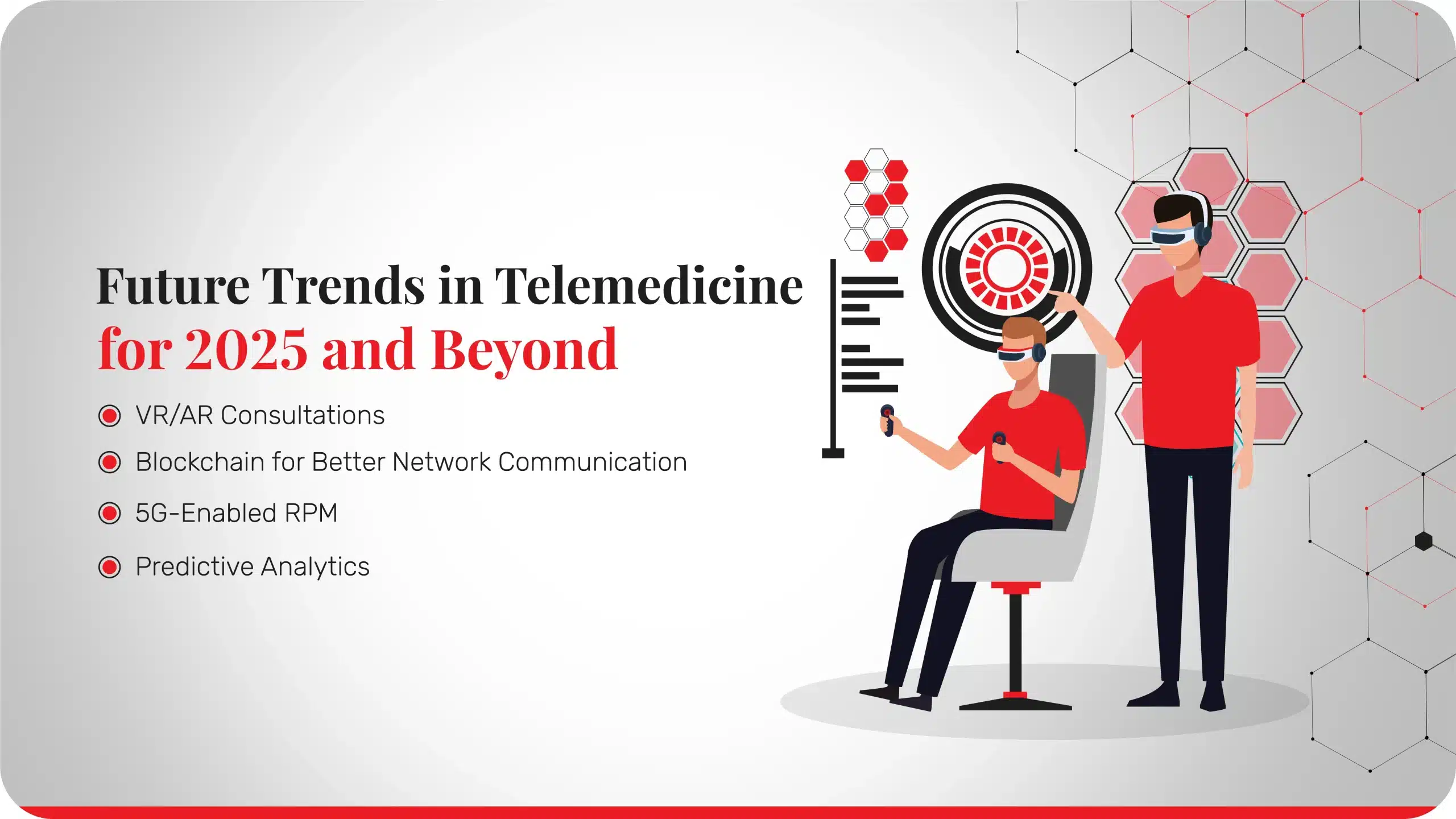
AI Reducing Healthcare Costs: Real Savings Backed by 7 Startup Case Studies
Look at the real numbers from healthcare organizations that show AI reducing healthcare costs in real. The AI lens makes costs look controllable.
Continue Reading
What if your next doctor’s visit could happen from your couch without sacrificing quality, speed, or security?
Sounds convenient, right?
As digital health moves forward, telemedicine app development is driving many changes in patient care, saving money, and overcoming areas where hospitals are far from people. By 2025, if healthcare providers want to stay ahead, investing in telemedicine app development will be crucial.
Telemedicine refers to delivering healthcare services remotely through digital platforms without physical visits. Patients have the facility of consulting doctors, receiving diagnoses, getting prescriptions, and managing health records remotely using their smartphones or tablets. The shift toward virtual healthcare has made healthcare services more accessible, efficient, and safe, particularly for global events like COVID-19, when physical interactions are the last thing needed. According to Appinventiv, telehealth is expected to reach a market size of USD 55.6 billion by the end of the year 2025.
Healthcare services can be expensive, especially for people in rural areas who can’t afford to visit the doctor. Virtual healthcare apps allow doctors to monitor patients without any physical visits, which saves patients time and cost. This technology has expanded to cover general consultations, health record management, mental health support, chronic disease management, and even postoperative care. In today’s world, telehealth apps have proven to be convenient for both patients and doctors, and looking to modernize their services.
Telemedicine is now commonly used because of the changes brought on by the pandemic. The convenience of staying at home for small or repeated problems is preferred by many patients. It addresses the daily demands of a tech-driven society.
The online doctor app allows a practice of spending less money on clinics, utilities, and front-desk personnel. Patients do not need to spend extra money on traveling and miss work unnecessarily. It provides a low-cost way for hospitals and patients.
Doctors are not easily accessible to people living in rural or underserved regions. It makes it simpler to deal with unexpected doctor shortages and challenges in traveling. This promotes fairness in health care.
Setting up and carrying out a virtual visit is quicker than an in-person meeting. More patients can be attended to each day, and their waiting time is shorter. The virtual healthcare app can help enhance employees’ working habits and overall happiness.
Virtual healthcare apps can connect with smartwatches and health trackers to monitor our vital signs. Real-time feedback allows doctors to make better decisions.AI tools play a role in the early detection of diseases.
Patients can receive a reminder about taking their medicine, keeping their appointments, and improving their lifestyle through apps. Features tailored to each user help them feel valued. This leads to loyal users who continue to use the remote patient monitoring app for a long time.
A more comfortable experience for users is made possible with AI chatbots, mental health support, or multilingual resources. Innovating the online doctor app allows it to stand out from others in the market.
Telehealth app owners have the option to make money through charging fees for subscriptions, for each consultation, or through agreements with pharmacies and labs. Relying on several kinds of income allows the business to grow.
A virtual healthcare app eliminates the need to travel and use paper for most care. It aids in upholding environmental healthcare practices and cuts down its impact on the environment.
Among many remote patient monitoring apps, the Amwell app stands out for offering reliable, user-friendly online consultations. As one of the pioneers in telemedicine app development, it connects patients with licensed doctors. They cover every need of a patient, from urgent cases to behavioral healthcare services. The reason the Amwell app development stands out is because of its advanced functionality and accessibility. It provides a variety of services, including couples therapy, dialectical behavior therapy, grief counseling, life transitions, LGBTQ counseling, nutrition counseling, online pediatrics, online psychiatry, stress management, online therapy, online urgent care, and women’s health.
Although Amwell’s digital healthcare game is on point with 80 million members benefiting from their extensive services, healthcare providers who are aiming to build a remote patient monitoring app and stand out, like Amwell, should be able to understand the basic critical elements needed to make a virtual healthcare app reliable, safe, and most importantly effective. Let’s have a look at what it takes to build a telemedicine app like Amwell in 2025:

Telemedicine app development like Amwell requires building features that ensure patient satisfaction, reliability, and clinical efficiency. The following are the must-have features:
To enable safe and secure video calls between patients and healthcare providers, the telemedicine app development should include high-quality video and audio capabilities, while ensuring security is a top priority in telemedicine app development.
Healthcare providers must be able to provide prescriptions digitally after diagnosis, and patients can get medicines through delivery partners on time.
Doctors should be able to access the electronic health records of their patients for better consultation and diagnosis.
Building manual inputs or wearables to monitor patients vitals and chronic conditions remotely.
Patients and healthcare providers must be able to communicate through messages for follow-ups and get automated reminders for appointments and medicine intake.
Secure financial transactions through debit and credit cards, including insurance and co-payments.
Patients can use AI to get a pre-diagnosis of their symptoms before consulting a doctor, which will lead to time effectiveness for both patients and doctors.
The most important feature of a telemedicine app is its user-friendly interface. Patients using online doctor apps are usually from rural areas. Users should be able to easily access their reports, records, schedule or cancel appointments, and consult with the doctor for an effective outcome. The Amwell app puts this into practice by being user-friendly for everyone, so all patients, even those not very familiar with technology, can easily use it, get updated on their health information, and speak with their doctors.
The User Interface plays an important role in the success of a telemedicine app. If the UI is well designed, patients and healthcare providers will find it easy to use telehealth services. The main concern is to present features that are easy to use, accessible, and meet people’s assumptions about the app. For example, the Amwell app development is known for its intuitive, easy-to-understand, and straightforward way to arrange appointments. These are the top tips for designing a successful UI for a remote patient monitoring app:
Virtual healthcare app users should understand every step and not feel lost or overwhelmed. Users can finish their tasks easily when the page layout is simple, important buttons are visible, and the page does not require a lot of mental effort. Avoiding overdoing things in simple steps is necessary for less-stressed users. According to Coolest Gadgets, the number of people aged 65 or older using remote patient monitoring apps is more than the people aged 18-19, which suggests it is important for the telemedicine app to be accessible and intuitive. Amwell app development is a great example of this approach, offering a clean and familiar interface that allows even older adults to book appointments and access care without confusion.
The front page features of the digital healthcare app should focus on tools such as booking appointments, consultations by phone or video, accessing health records, and getting reminders for medicines. Amwell app development shows that incorporating access to calendars and medical charts with just a tap helps increase engagement and make things less complicated for users.
Remote patient monitoring apps should use specific healthcare and general related icons, such as doctor illustrations, medical equipment, and a calendar, can help users understand how to operate the app better. Icons can be helpful for those people who, for any reason, can’t understand the written content.
Typography should be designed so that it is readable by people with visual impairments. Improved readability depends on using the correct type of font, size, and contrast. Avoid using fancy fonts and difficult-to-read colors in your designs, as this will allow the online doctor app to be accessible for the visually impaired.
It is important to keep in mind that many users might not be familiar with complex medical terms, so keeping the language of the digital healthcare app simplified is preferable.
The remote patient monitoring app should have a consistent, friendly tone in messages, paired with features like AI chatbots or helpful prompts, which can build trust. Even in automated interactions, the language should feel caring, not robotic.
Accessibility should always be a basic priority. For example, high-contrast mode, large elements to touch on screen, and supporting colors for the color blind should be added. The app should also perform well on any device and screen size, as many users will use it on different gadgets. The Amwell app ensures the platform is user-friendly, inclusive, and functional for everyone, regardless of ability.
The telemedicine app UI is always evolving. Staying updated on design best practices, accessibility standards, and user feedback helps the online doctor app remain competitive. Iterative design and regular updates, like those seen in Amwell app development, can ensure the app meets changing user needs over time.
Having a well-designed front-end is only the initial part. Reaching true success in telemedicine app development needs strong partnerships, strict compliance, and constant shared support. Below are the important factors behind the standout performance delivered in the Amwell app development
It is important to have medical professionals taking part in care. Other than making the app attractive and user-friendly, applying for certification with clinics or hospitals is essential to provide actual health care. This implies that when people try a healthcare app supported by healthcare specialists, they are relying on the advice of doctors with experience and credibility, not just automatic suggestions. Besides, being approved by healthcare institutions and clinics further strengthens people’s trust in the information provided by the app. Amwell app development centers on having certified doctors and strong relationships with top healthcare systems, increasing patient trust, and helping to maintain high-quality care.
Healthcare app development requires compliance with both local laws and medical rules. Different states in the U.S. have their own rules for healthcare apps. In addition, any application that includes medical information should follow HIPAA and other privacy rules. Failing to comply can lead to legal action and loss of credibility.
The simple front end of a healthcare app is made possible by a strong backend system. There must be security-focused servers, cloud services, a function for handling video calls, online scheduling, managing prescriptions, and ways to encrypt information, all without causing any breakdowns.
Users are entrusting the app security to protect their data. Data should be protected by features such as secured messages, strong passwords, and user authentication.
Once the healthcare app development is completed, the team has to keep working further. They must update the online doctor app regularly, keep fixing bugs, offer support to users, and improve its speed to make everyone satisfied.
A lot of the users in this age group are learning about the virtual healthcare app for the first time. Providing clear instructions on using the app can increase their confidence in using it.
At this point, marketing, social media campaigns, SEO friendly content, and partnerships are the core strengths to promote anything, just like other businesses. A healthcare app also requires these practices to reach its target audience and form a community of trust within the telehealth app.
Understanding users’ needs and wants about the user interface or user experience of the app is really important in telemedicine app development to satisfy the members and gain their loyalty.
Healthcare app development requires thoughtful investment. Here’s an approximate cost breakdown:
| Development Level | Estimate Cost $ |
| UI/UX Design | $1,000 – $5,000 |
| Frontend and Backend Development | $20,000 – $50,000 |
| RPM Features | $10,000 – $20,000 |
| Video Calling and Chat Integration | $5,000 – $10,000 |
| EMR Integration | $8,000 – $15,000 |
| Admin Dashboard Development | $5,000 – $10,000 |
| Security and Compliance | $10,000 – $20,000 |
| Testing and Quality Assurance | $5,000 – $10,000 |
| Maintenance | 15%-12 % of the initial development cost |
The total estimated cost of a telemedicine app development is around $90,000 to $200,000. Healthcare app development costs may vary due to different features and design integration.
Healthcare app development is a specialized area, and costs may rise with advanced features like video consultations, EHR integration, AI chatbots, or custom dashboards for doctors and patients.
If you’re looking to create a virtual healthcare app, DigiTrends offers complete telemedicine app development services, from idea to execution. Whether you’re starting from scratch or improving an existing app, we can help bring your digital healthcare app vision to life.

Healthcare apps are hugely successful nowadays. They have made healthcare more affordable, available, and accessible to many people. Since 2020, healthcare apps have advanced significantly, and today, they are changing the delivery of healthcare across the world.
Telemedicine is expected to expand in the future. As technology progresses and the focus on patients increases, telehealth is undergoing notable changes. Let’s have a look at a few major topics and future trends guiding the progress of telemedicine apps in and post-2025:
It is evident that Artificial Intelligence plays an important role in the healthcare industry, and in healthcare apps, AI will be important in delivering personalized care to people. AI would allow members to spot diseases at an early stage, based on health data measured from each person, and choose the most suitable treatment plan.
In the future, health monitoring gear will help communicate closely with remote patient monitoring apps. They will track and send data on heart rate, sleep, blood sugar, and many other things, so people do not require frequent visits to doctors.
Mental health is no longer taboo, people are now aware of their mental conditions and more open to getting help. In 2025, people will be able to get virtual therapy through online doctor apps. This would be a convenient option for people struggling with anxiety, they would be able to get support for stress, anxiety, and depression through AI tools, instant therapy session appointments, and virtual group therapy sessions.
Since patient data is increasingly moving online, the healthcare app development team should maintain stronger data confidentiality. Using improved encryption, blockchain for tracking and following HIPAA and GDPR rules will help keep patients’ data confidential.
Using VR and AR technologies will improve physical therapy, managing pain, and education for medical students. Those who have just had an injury or surgery can get therapy sessions at home. AR can also be used by medical professionals for expert advice or interaction with others remotely. Over the years, VR/AR will make it possible for people to achieve positive treatment outcomes from home.
If electronic health records are seamlessly connected, doctors would be able to see the patient’s past health information during online visits, which would help them give informed advice. With this system, health professionals can avoid being tested again and risk fewer errors because there are no gaps in the patient’s history. Doctors can see patients’ progress, check if they are taking the prescribed medicines, and review laboratory reports altogether. EHR-connected telehealth apps allow physicians to give patients personal and timely care, as well as maintain their medical histories.
Since 5G networks are now available, their integration in telemedicine apps can help transfer data and communicate through video at unprecedented speeds. With this kind of connectivity, doctors can offer immediate advice to anyone, anywhere. Patients from rural areas can undergo an ultrasound or similar procedure guided by specialists in the local clinics or hospitals available in their areas.
Digital healthcare relies heavily on protecting a patient’s data. Storing health records on the blockchain prevents unauthorized changes and allows patients to permit access to only certain people. It also simplifies tasks such as insurance claims by using smart contracts.
Telemedicine is likely to use genetic information to provide personalized care. It means doctors can now use DNA and wellness plans to advise on treatment or prevention after a remote consultation. This would allow patients to learn about genetic risks and receive customized lifestyle changes and medication plans during a virtual consultation.
Amwell app development is a benchmark, but other apps are offering similar and impressive features:
Selecting the right telemedicine app depends on your long-term digital health strategy and vision for target patients.
Is 2025 the right time for telemedicine app development? The answer is yes!
Telemedicine is no longer a convenient alternative but a requirement for this modernized world. Creating an application similar to Amwell presents a great potential to transform healthcare through virtual medical service connectivity for patients across the globe. The healthcare needs of the contemporary era receive efficient and affordable solutions through online doctor apps, which provide remote patient monitoring and mental health assistance. An advanced telemedicine app commitment today allows providers to achieve these targets because companies like DigiTrends have dedicated teams that specialize in building custom healthcare app solutions, making it easier for healthcare providers to meet their goals and stay ahead in the digital healthcare space.
